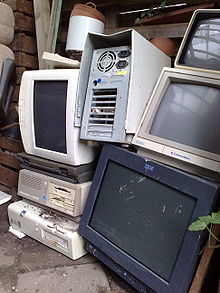Hoarding (left), disassembling (center) and collecting (right) electronic waste in
Bengaluru, India
E-waste or electronic waste is created when an
electronic product is discarded after the end of its useful life. The rapid expansion of
technology means that a very large amount of e-waste is created every minute.
[3]
Electronic waste or e-waste may be defined as discarded computers, office electronic equipment, entertainment device
electronics,
mobile phones,
television sets, and
refrigerators. This includes used electronics which are destined for reuse, resale, salvage, recycling, or disposal as well as re-usables (working and repairable electronics) and secondary scraps (copper, steel, plastic, etc.). The term "waste" is reserved for residue or material which is dumped by the buyer rather than recycled, including residue from reuse and recycling operations, because loads of surplus electronics are frequently commingled (good, recyclable, and non-recyclable). Several public policy advocates apply the term "e-waste" and "e-scrap" broadly to all surplus electronics.
Cathode ray tubes(CRTs) are considered one of the hardest types to recycle.
[4]
CRTs have a relatively high concentration of lead and
phosphors (not to be confused with phosphorus), both of which are necessary for the display. The
United States Environmental Protection Agency (EPA) includes discarded CRT monitors in its category of "hazardous household waste"
[5] but considers CRTs that have been set aside for testing to be commodities if they are not discarded, speculatively accumulated, or left unprotected from weather and other damage. These CRT devices are often confused between the DLP Rear Projection TV, both of which have a different recycling process due to the materials they are composed of.
The EU and its member states operate a system via the European Waste Catalogue (EWC) - a European Council Directive, which is interpreted into "member state law". In the UK, this is in the form of the List of Wastes Directive. However, the list (and EWC) gives a broad definition (EWC Code 16 02 13*) of what is hazardous electronic waste, requiring "waste operators" to employ the Hazardous Waste Regulations (Annex 1A, Annex 1B) for refined definition. Constituent materials in the waste also require assessment via the combination of Annex II and Annex III, again allowing operators to further determine whether a waste is hazardous.
[6]
Debate continues over the distinction between "commodity" and "waste" electronics definitions. Some exporters are accused of deliberately leaving difficult-to-recycle, obsolete, or non-repairable equipment mixed in loads of working equipment (though this may also come through ignorance, or to avoid more costly treatment processes). Protectionists may broaden the definition of "waste" electronics in order to protect domestic markets from working secondary equipment.
The high value of the
computer recyclingsubset of electronic waste (working and reusable laptops, desktops, and components like
RAM) can help pay the cost of transportation for a larger number of worthless pieces than what can be achieved with display devices, which have less (or negative) scrap value. In A 2011 report, "Ghana E-Waste Country Assessment",
[7]found that of 215,000 tons of electronics imported to Ghana, 30% were brand new and 70% were used. Of the used product, the study concluded that 15% was not reused and was scrapped or discarded. This contrasts with published but uncredited claims that 80% of the imports into Ghana were being burned in primitive conditions.




There are few good service providers which can help in E Waste recycling. Most of the services have no cost so it try. Let's save environment.
ReplyDeleteDispose your Laptop great price for your old device with no hidden charges, free returns & free data erasure, get paid for it! Please get more info on it equipment disposal.
ReplyDelete